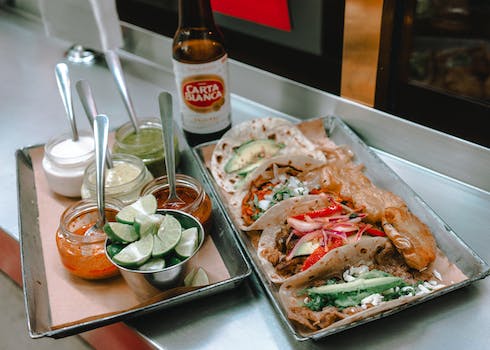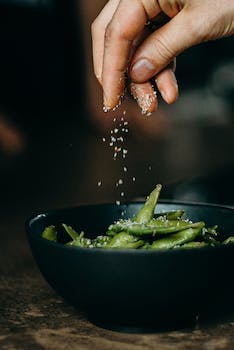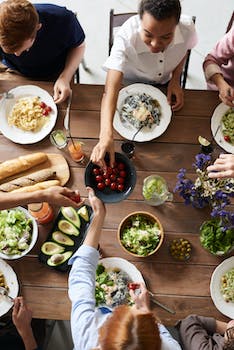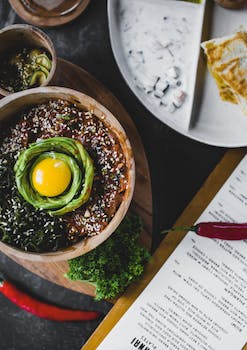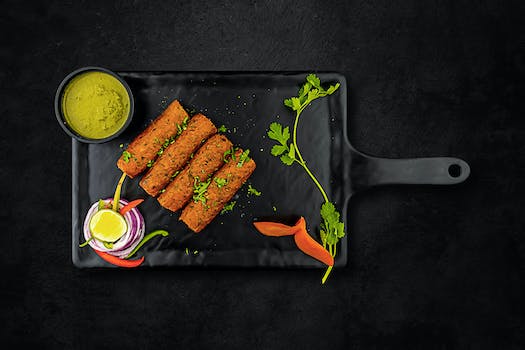

-
Table of Contents
Unveiling South Africa's Flavorful Past: Part 1
Introduction
Introduction:
In this two-part series, we will be exploring South Africa's rich culinary heritage. South Africa is a country known for its diverse cultural influences, and its cuisine reflects this diversity. From traditional African dishes to European and Asian-inspired flavors, South African cuisine offers a unique and exciting culinary experience. In Part 1, we will delve into the traditional dishes and cooking techniques that have shaped South Africa's culinary heritage. Join us as we embark on a flavorful journey through the tastes and traditions of South Africa.
Traditional South African Dishes: A Journey into the Country's Culinary Roots
South Africa is a country known for its rich cultural heritage, and this extends to its culinary traditions as well. Traditional South African dishes are a reflection of the country's diverse history and the fusion of different cultures that have shaped its cuisine over the years. In this article, we will take a journey into the country's culinary roots and explore some of the most iconic traditional dishes.
One of the most famous traditional South African dishes is bobotie. This dish is a perfect example of the fusion of flavors that characterizes South African cuisine. Bobotie is a baked dish made with minced meat, usually beef or lamb, mixed with spices, herbs, and dried fruit. It is then topped with a savory custard made from eggs and milk. The result is a delicious combination of sweet and savory flavors that is truly unique to South Africa.
Another traditional dish that is a staple in South African cuisine is boerewors. Boerewors is a type of sausage that is made from a mixture of beef, pork, and spices. It is often cooked on an open flame or braai, which is the South African term for barbecue. Boerewors is a favorite at social gatherings and is often served with pap, a type of porridge made from maize meal. The combination of the smoky, flavorful sausage and the creamy pap is a match made in culinary heaven.
Bunny chow is another iconic South African dish that has its roots in the country's Indian community. Bunny chow is essentially a hollowed-out loaf of bread filled with curry. The dish originated in Durban, which has a large Indian population, and has since become popular throughout the country. Bunny chow is a hearty and flavorful dish that is perfect for a quick and satisfying meal.
Moving on to desserts, malva pudding is a traditional South African sweet treat that is sure to satisfy any sweet tooth. Malva pudding is a sticky, moist sponge cake that is made with apricot jam and served warm with a creamy sauce. It is often enjoyed with a scoop of vanilla ice cream or custard. The origins of malva pudding can be traced back to Dutch settlers in South Africa, who brought with them their love for sweet, indulgent desserts.
Lastly, we cannot talk about traditional South African dishes without mentioning biltong. Biltong is a type of dried and cured meat that is similar to beef jerky. It is typically made from beef, but can also be made from game meats such as ostrich or kudu. Biltong is a popular snack in South Africa and is often enjoyed with a cold beer. The process of making biltong involves marinating the meat in a mixture of vinegar, salt, and spices, and then air-drying it until it reaches the desired texture.
In conclusion, traditional South African dishes are a testament to the country's diverse cultural heritage and the fusion of different culinary traditions. From the sweet and savory flavors of bobotie to the smoky goodness of boerewors, these dishes offer a taste of South Africa's rich culinary roots. Whether you're a meat lover or have a sweet tooth, there is something for everyone to enjoy in South African cuisine. Stay tuned for Part 2 of our exploration into South Africa's culinary heritage, where we will delve into the country's regional specialties.
The Influence of Indigenous Ingredients on South African Cuisine

South Africa is a country rich in cultural diversity, and this diversity is beautifully reflected in its cuisine. The culinary heritage of South Africa is a fascinating blend of indigenous ingredients, traditional cooking techniques, and influences from various cultures that have settled in the country over the centuries. In this two-part series, we will explore the different aspects of South Africa's culinary heritage, starting with the influence of indigenous ingredients on its cuisine.
Indigenous ingredients play a crucial role in South African cuisine, as they have been used by the indigenous people of the region for centuries. These ingredients not only provide unique flavors but also showcase the rich biodiversity of the country. One such ingredient is the marula fruit, which is native to Southern Africa. The marula fruit is used to make a popular liqueur called Amarula, which has gained international recognition. The fruit is also used in traditional dishes, such as marula jelly and marula cake, adding a distinct flavor to these delicacies.
Another indigenous ingredient that has made its mark on South African cuisine is the rooibos plant. Rooibos tea, made from the leaves of this plant, has gained popularity worldwide for its health benefits and unique taste. In South Africa, rooibos tea is not only enjoyed as a hot beverage but is also used in cooking. It is often used to infuse flavor into dishes like rooibos-infused chicken or rooibos-infused desserts, adding a subtle earthy note to the food.
One cannot talk about indigenous ingredients without mentioning the staple food of South Africa, maize. Maize, also known as corn, has been a dietary staple for the indigenous people of South Africa for centuries. It is used in various forms, such as maize meal, which is ground into a fine powder and used to make porridge or pap, a popular dish in South Africa. Maize is also used to make mielie bread, a traditional bread that is enjoyed with stews and soups. The versatility of maize makes it an essential ingredient in South African cuisine.
Indigenous ingredients are not only limited to fruits, plants, and grains but also include a variety of meats. Game meat, such as venison, is a popular choice in South African cuisine. The indigenous people of South Africa have been hunting game for centuries, and this tradition has influenced the country's culinary practices. Venison is often used in traditional dishes like biltong, a type of dried and cured meat, and potjiekos, a slow-cooked stew made in a cast-iron pot. The flavors of game meat are distinct and add a unique element to South African cuisine.
The influence of indigenous ingredients on South African cuisine is undeniable. These ingredients not only provide a taste of the country's rich biodiversity but also showcase the culinary traditions of its indigenous people. From the marula fruit to rooibos tea, maize, and game meat, these ingredients have shaped the flavors and textures of South African dishes. In part two of this series, we will explore the influence of other cultures on South African cuisine, further highlighting the diversity and richness of this culinary heritage.
Exploring the Fusion of Cultures in South African Food
South Africa is a country known for its rich cultural diversity, and this diversity is reflected in its cuisine. South African food is a fusion of various cultures, resulting in a unique culinary heritage that is both diverse and delicious. In this article, we will explore the fusion of cultures in South African food, taking a closer look at how different influences have shaped the country's culinary landscape.
One of the major influences on South African cuisine is the indigenous African culture. The indigenous people of South Africa have a long history of farming and foraging, and their traditional dishes often feature ingredients such as maize, millet, and sorghum. These grains are used to make staple foods like pap, a porridge-like dish that is often served with meat or vegetables. Indigenous African cuisine also includes a variety of game meats, such as springbok and kudu, which are often cooked over an open fire.
Another significant influence on South African food is the Dutch colonial heritage. The Dutch arrived in South Africa in the 17th century and brought with them their own culinary traditions. One of the most famous Dutch contributions to South African cuisine is the boerewors, a type of sausage that is often enjoyed at braais, or barbecues. The Dutch also introduced the tradition of baking bread, and today, South African breads like potbrood and roosterkoek are popular throughout the country.
The British colonial period also left its mark on South African food. The British brought with them their love for tea and introduced the tradition of afternoon tea to South Africa. Today, tea is a popular beverage in South Africa, and many South Africans enjoy a cup of rooibos tea, a local herbal tea, with their meals. The British also introduced the tradition of eating fish and chips, which is still enjoyed by many South Africans today.
The influence of the Indian community on South African cuisine cannot be overlooked. Indian immigrants arrived in South Africa in the 19th century, bringing with them their vibrant spices and flavors. Indian cuisine has had a significant impact on South African food, with dishes like bunny chow, a hollowed-out loaf of bread filled with curry, becoming a popular street food. Indian spices like curry powder and masala are commonly used in South African cooking, adding a unique flavor to many dishes.
Lastly, the Malay community has also played a role in shaping South African cuisine. The Cape Malay community, descended from slaves brought to South Africa from Southeast Asia, has a distinct culinary tradition that combines Indonesian, Malaysian, and African flavors. Cape Malay dishes often feature ingredients like coconut milk, curry leaves, and spices like cinnamon and cardamom. Bobotie, a spiced meat dish topped with an egg-based custard, is a classic Cape Malay dish that is enjoyed by many South Africans.
In conclusion, South African food is a fusion of various cultures, resulting in a culinary heritage that is diverse and flavorful. From indigenous African dishes to Dutch, British, Indian, and Cape Malay influences, South African cuisine reflects the country's rich cultural diversity. Exploring the fusion of cultures in South African food is a fascinating journey that allows us to appreciate the unique flavors and traditions that make up this vibrant culinary landscape.
Q&A
1. What is South Africa's culinary heritage?
South Africa's culinary heritage is a diverse blend of indigenous African, European, and Asian influences.
2. What are some traditional South African dishes?
Some traditional South African dishes include bobotie (a spiced minced meat dish), boerewors (a type of sausage), biltong (dried cured meat), and malva pudding (a sweet dessert).
3. How has South Africa's culinary heritage evolved over time?
South Africa's culinary heritage has evolved through centuries of colonization and immigration, resulting in the fusion of different cooking styles and ingredients from various cultures.
Conclusion
In conclusion, exploring South Africa's culinary heritage in Part 1 has provided insights into the diverse and rich food culture of the country. From traditional dishes like bobotie and boerewors to the influence of various cultures such as Malay and Indian, South African cuisine showcases a fusion of flavors and ingredients. The exploration of indigenous ingredients like rooibos tea and marula fruit further highlights the unique culinary heritage of the country. Overall, South Africa's culinary heritage is a vibrant tapestry of flavors, reflecting its diverse history and cultural influences.


